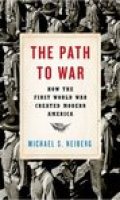 The Deluge: The Great War, America and the Remaking of the Global Order, 1916-1931
The Deluge: The Great War, America and the Remaking of the Global Order, 1916-1931 by
Adam Tooze ISBN: 0670024929
Published by Viking on November 13, 2014
Genres: Strategic Studies Pages: 672
Winner of the 2015 Los Angeles Times Book Prize
Author Tooze, a previous winner of the (UK) Wolfson Foundation History Prize, has written a richly detailed book of how France and Great Britain, working with the United States, formed a workable triumvirate that won the war in 1918, only to have it unravel over the following decade. The Deluge tackles the big picture from Tooze’s chosen turning point in the Great War and America’s economic rise to a major world power.
The New York Times review called it “Splendid interpretive history.” Reviewer Gary D. Bass explained, “Rather than starting at a conventional moment like the outbreak of World War I, Tooze begins midstream in 1916 — the year of the gory battles of Verdun and the Somme, but also the year when the economic output of the United States exceeded that of the British Empire. From then until today, writes Tooze, a professor of history at Yale, American economic might would be the decisive factor in the shaping of the world order.”
Professor Kevin Matthews of George Mason University stated in his review that “On reflection, America’s emergence should have surprised no one. As Paul Kennedy pointed out in The Rise and Fall of the Great Powers, by 1900 the United States was already the world’s leading manufacturing power, with Britain and Germany battling for second place. So, a change was coming; sooner or later, the world’s financial and political center of gravity would cross the Atlantic. What no one could have predicted was how sudden this move would be, a suddenness that ‘was a product of the Great War’ (pp. 40–1).”
President Woodrow Wilson so distrusted the European leaders that he offered his own 14 points and peace without victory, infuriating his two allies. Wilson was not interested in joining the Europeans in ruling the world, preferring his idea of a League of Nations.
Bass summarized: “So Tooze narrates the tumultuous and violent 1920s as a heartbreakingly avoidable tragedy, with the big democracies needlessly squandering their supremacy. Above all, grand liberal projects would never succeed without American engagement. With the United States emerging exponentially more powerful from the war, France and Britain would need its support to deter possible new German aggression. Even when the United States refused to assert itself, Tooze argues, the interwar order ‘was defined in large part by the absent presence of its most defining element — the new power of the United States.’”
America’s lack of engagement in world affairs left other nations to struggle with their own rebuilding. Many chose protective tariffs, a return to the gold standard, and austerity to pay down war debt. These decisions meant a post-war recession became the Great Depression as less money and limited credit left nothing to help rebuild.
The Deluge is an enormously worthwhile book, worldwide in scope, and recommended reading.
Reviewed by Anne Merritt
 Admiral of the Fleet Earl Beatty by Stephen Wentworth Roskill
Admiral of the Fleet Earl Beatty by Stephen Wentworth Roskill 


 The Zimmermann Telegram by
The Zimmermann Telegram by  Jutland: The Naval Staff Appreciation by
Jutland: The Naval Staff Appreciation by  Jutland: The Unfinished Battle: A Personal History of a Naval Controversy by
Jutland: The Unfinished Battle: A Personal History of a Naval Controversy by  Jutland: World War I's Greatest Naval Battle by
Jutland: World War I's Greatest Naval Battle by  The Battle of Jutland by
The Battle of Jutland by  Churchill and the Dardanelles by
Churchill and the Dardanelles by  The Naval Route to the Abyss by
The Naval Route to the Abyss by  To Crown the Waves by
To Crown the Waves by  Clash of Fleets by
Clash of Fleets by  From the Dreadnought to Scapa Flow by
From the Dreadnought to Scapa Flow by  A Naval History of World War I by
A Naval History of World War I by  Fighting the Great War at Sea by
Fighting the Great War at Sea by  Zeppelin vs British Home Defence 1915-18 by
Zeppelin vs British Home Defence 1915-18 by  German Infantryman vs Russian Infantryman – 1914–15 by
German Infantryman vs Russian Infantryman – 1914–15 by  American Military Vehicles of World War I by
American Military Vehicles of World War I by  The Vanquished by
The Vanquished by  Pershing's Crusaders: The American Soldier in World War I by
Pershing's Crusaders: The American Soldier in World War I by  Victory on the Western Front: The Development of the British Army 1914-1918 by
Victory on the Western Front: The Development of the British Army 1914-1918 by  The Deluge: The Great War, America and the Remaking of the Global Order, 1916-1931 by
The Deluge: The Great War, America and the Remaking of the Global Order, 1916-1931 by  The Path to War: How the First World War Created Modern America by
The Path to War: How the First World War Created Modern America by  Ottomans and Armenians: A Study in Counterinsurgency ISBN: 1137362200
Ottomans and Armenians: A Study in Counterinsurgency ISBN: 1137362200  King of Battle: Artillery in World War I by
King of Battle: Artillery in World War I by  Instrument of War: The German Army 1914–18 by
Instrument of War: The German Army 1914–18 by  Empires in World War I: Shifting Frontiers and Imperial Dynamics in a Global Conflict by
Empires in World War I: Shifting Frontiers and Imperial Dynamics in a Global Conflict by  The British Imperial Army in the Middle East: Morale and Military Identity in the Sinai and Palestine Campaigns, 1916-18 by
The British Imperial Army in the Middle East: Morale and Military Identity in the Sinai and Palestine Campaigns, 1916-18 by  Over the Top: Alternate Histories of the First World War by
Over the Top: Alternate Histories of the First World War by  World War I: The Definitive Encyclopedia and Document Collection by
World War I: The Definitive Encyclopedia and Document Collection by  And the World Went Dark: An Illustrated Interpretation of the Great War by
And the World Went Dark: An Illustrated Interpretation of the Great War by  The Russian Army in the Great War: The Eastern Front, 1914-1917 by
The Russian Army in the Great War: The Eastern Front, 1914-1917 by  The French Army and the First World War by
The French Army and the First World War by  The British Army and the First World War by
The British Army and the First World War by  The American Army and the First World War by
The American Army and the First World War by  Germany’s Western Front: 1914, Part 1: The Battle of the Frontiers and Pursuit to the Marne, by
Germany’s Western Front: 1914, Part 1: The Battle of the Frontiers and Pursuit to the Marne, by  Germany’s Western Front by
Germany’s Western Front by  Letters from the Boys: Wisconsin World War I Soldiers Write Home by
Letters from the Boys: Wisconsin World War I Soldiers Write Home by  The Great War Comes to Wisconsin: Sacrifice, Patriotism, and Free Speech in a Time of Crisis by
The Great War Comes to Wisconsin: Sacrifice, Patriotism, and Free Speech in a Time of Crisis by  Unheard Voices, Untold Stories by
Unheard Voices, Untold Stories by  Unheard Voices, Untold Stories, Volume 2 by
Unheard Voices, Untold Stories, Volume 2 by  Admiral Frank H. Schofield: A Portrait in Letters of an American Navy Family (the Years 1886-1942) by
Admiral Frank H. Schofield: A Portrait in Letters of an American Navy Family (the Years 1886-1942) by  Hunters and Killers: Volume 1: Anti-Submarine Warfare from 1776 to 1943 by
Hunters and Killers: Volume 1: Anti-Submarine Warfare from 1776 to 1943 by  The Yanks Are Starving: A Novel of the Bonus Army by
The Yanks Are Starving: A Novel of the Bonus Army by  NATIONAL FLOWERS: The Battle of Verdun 1916 by
NATIONAL FLOWERS: The Battle of Verdun 1916 by 
